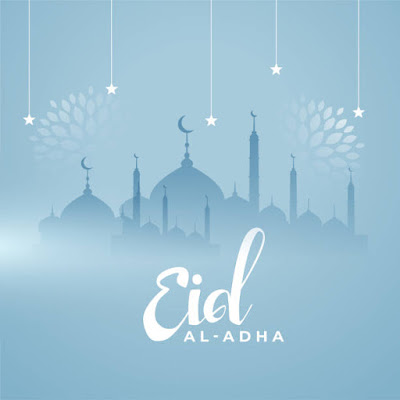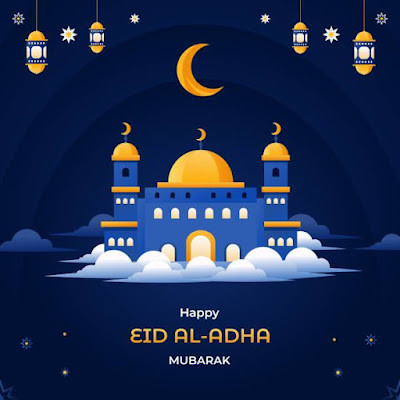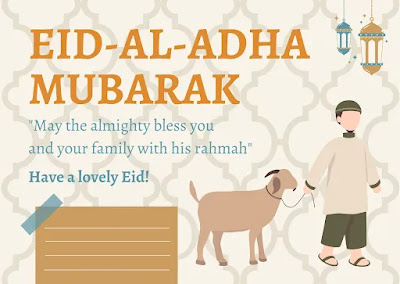Introduction
Eid ul Adha, also called the Festival of Sacrifice, is a big religious holiday that Muslims all over the world enjoy. It's a way to remember that Ibrahim (Abraham) was ready to sacrifice his son to please God. As part of the celebrations, people tell their loved ones how much they care and wish them well. Greeting cards for Eid ul Adha are an important way to show happiness, love, and unity during this happy time. In this piece, we'll talk about what Eid ul Adha greeting cards mean, how they look, and how they add to the holiday spirit.
Eid ul Adha Greeting cards help spread love and happiness.
Muslims all over the world have a special place in their hearts for Eid ul Adha welcome cards. With these cards, you can send warm wishes, love, and gifts to family, friends, and other people you know. During this holy holiday, they represent unity, happiness, and the spirit of giving. Whether they are given in person or sent in the mail, Eid ul Adha birthday cards make people happy and create memories that will last a long time.
What Do Greeting Cards for Eid ul Adha Mean?
Greeting cards for Eid ul Adha are a way to show love, respect, and thanks. They have cultural and religious meanings that help people connect with their faith and enjoy the good things that have happened to them. Many of the designs on these cards are religious, like mosques, crescents, and verses from the Quran. This is to remember the recipients of the spiritual meaning of Eid ul Adha.
Designs and themes for greeting cards for Eid ul Adha
Traditional Symbols and Motifs: Many Eid ul Adha greeting cards have traditional symbols like lanterns, sheep, camels, and intricate geometric designs. These parts of the festival show the event's rich cultural history.
writing and Arabic Typography: Islamic writing and Arabic typography are often used to make Eid ul Adha greeting cards. The beautiful and artsy way the Arabic text is put together gives the cards more depth and style.
Designs that are based on nature: Many people choose Eid ul Adha greeting cards with themes like blooming flowers, lush green scenery, and quiet moonlit nights. They make you feel peaceful and grateful for the nature world.
Animal Pictures: Since Eid ul Adha is a time to remember how Ibrahim was ready to sacrifice his son, many greeting cards have pictures of sheep, which was the animal that was sacrificed. These pictures show what it means to give, to obey, and how important faith is.
The Eid ul Adha holiday is a time for family and community members to get together. Greeting cards often show pictures of families getting together to share food and do good deeds. These ideas show how important it is to work together.
Religious Elements: Eid ul Adha greeting cards have religious images and verses from the Quran. These things show how important the holiday is spiritually and remind people of what Islam teaches.
Making your own Eid ul Adha cards
Consider the following ways to change Eid ul Adha welcome cards to make them more personal and meaningful:
Personalised words: Write words from the heart that share your best wishes and blessings for the person receiving the card. Adding something personal shows that you care about them and are glad they are in your life.
Adding Family pictures: Putting family pictures in greeting cards gives them a warm and personal feel. It makes the person feel like they are a part of your family and makes the bonds between family members stronger.
Adding Quotations and Verses from Islam: Choose uplifting quotes from the Quran or other Islamic writing that fit with the spirit of Eid ul Adha. These quotes give the cards more depth and spiritual meaning.
Adding handmade touches: Use your imagination and add things like ribbons, pressed flowers, or writing that you made yourself. These unique touches show off your artistic skills and make the cards stand out.
Using Bright Colours and Patterns: Pick colours and patterns that make you feel happy, like a party or a celebration. People often think of colours like gold, green, and blue when they think of Eid ul Adha.
Choosing the Right Card Sizes: Think about how useful the card size is. Choose sizes that are easy to handle and can fit into envelopes for sending or handing out.
How technology has changed Eid al Adha cards
As technology has changed, so has the way Eid ul Adha welcome cards are sent. Here are some ways to say hello in the current world:
E-Cards and Digital Wishes: Electronic cards, or e-cards, are becoming more popular because they are more handy and better for the environment than paper cards. You can change these digital messages and send them via email or social media.
Platforms for social media: Platforms for social media give you a place to share digital messages with more people. Users can send personalised Eid ul Adha wishes to their friends and fans on Facebook, Instagram, and WhatsApp.
Augmented reality (AR) and virtual reality (VR): New technologies like AR and VR let people make greetings for Eid ul Adha that are interactive and immersive. These new ways improve the experience for the recipient and make the exchange memorable.
Sharing Eid ul Adha Cards of Greeting
Greeting cards for Eid ul Adha can be given to a wide range of people and groups, including:
Family and Friends: Use personalised greeting cards to send good wishes to your family and close friends. These cards make love stronger and celebrate the joy of being with someone.
coworkers and Business Partners: Send Eid ul Adha greeting cards to coworkers and business partners to build goodwill and keep up professional relationships. This action shows respect for different cultures and makes relationships stronger.
Community Groups and Mosques: Give greeting cards to people in community groups and mosques to spread the holiday joy to more people. This practise brings people together and makes them feel like they belong.
Eid ul Adha Greeting Cards as Keepsakes
Greeting cards for Eid ul Adha often have special meaning and are kept for a long time. People often keep these cards as mementos so they can remember the happy times they had at the event. Some people make scrapbooks or put up the cards to remember the blessings they got and the relationships they built during Eid ul Adha.
Conclusion
During the Festival of Sacrifice, Eid ul Adha cards are a beautiful and important way to show love, thanks, and unity. Whether they come in the form of traditional paper cards or more modern digital versions, these greetings play a big role in making Muslims around the world happy and bringing them closer together. By adding personal words and thoughtful designs, Eid ul Adha greeting cards become treasured keepsakes that capture the spirit of this happy holiday.
FAQs
How can I make sure that people notice my Eid ul Adha cards?
You can make your birthday cards stand out by giving them a unique look, a personal message, or touches that you made yourself. Use bright colours and themes that fit with what Eid ul Adha is all about.
Is there a special way to say hello or goodbye on Eid ul Adha?
People often say "Eid Mubarak" (which means "Blessed Eid") or "May your sacrifices be accepted." Add some heartfelt wishes and gifts to your messages to make them more personal.
Can I send e-greeting cards for Eid ul Adha?
Yes, e-cards, or electronic cards, are becoming a more common way to say happy Eid ul Adha. You can change them and send them by email or share them on social media sites.
Is it usual for people to send each other cards on Eid ul Adha?
Yes, welcome cards are often given and received on Eid ul Adha. It lets people show their love, gratitude, and well wishes to family, friends, and other people they know.
What should I write in a card for Eid ul Adha?
In a welcome card for Eid ul Adha, you can write warm wishes, blessings, and thanks. Personalise the message to show how you know the recipient and what the event means to you.






No comments :
Post a Comment